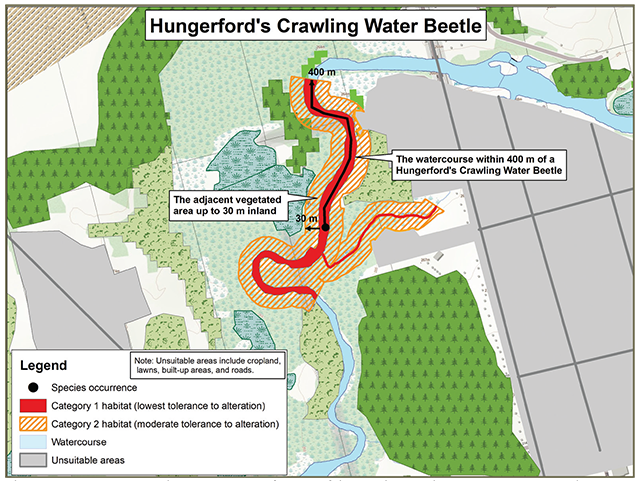Habitat Protection Summary for Hungerford’s Crawling Water Beetle
This document outlines a brief description of the area that is protected as habitat for Hungerford’s Crawling Water Beetle through a habitat regulation under the Endangered Species Act.
The Hungerford’s Crawling Water Beetle is a small aquatic beetle typically measuring less than five millimetres long. It lives in rivers and streams with good aeration and cool water temperatures. Individuals are often concentrated downstream of dams, weirs and culverts. It was assessed by Committee on the Status of Species at Risk in Ontario (COSSARO) and listed as endangered on January 13, 2012. More information about the species’ status and where it occurs in Ontario can be found at: Hungerford’s Crawling Water Beetle page.
Brief description of the habitat regulation
The habitat regulation for Hungerford’s Crawling Water Beetle protects the part of a river, stream or other watercourse, including a tributary, up to the high water mark that is within 400 metres of a Hungerford’s Crawling Water Beetle. This includes but is not limited to areas in the North Saugeen, Saugeen, and Rankin Rivers. Areas with natural and semi-natural vegetation, such as forest, woodland, thicket, wetland, old field, pasture, or meadow, within 30 metres of the protected aquatic area are also protected. Lawns and areas of agricultural cropland are not included.
Habitat categorization
The following text indicates how the species’ habitat would be categorized, as per the policy Categorizing and Protecting Habitat under the Endangered Species Act.
Category 1 (Red)
- The part of a river, stream or other watercourse, that is within 400 metres of where a Hungerford’s Crawling Water Beetle is found
Category 2 (Orange)
- Areas with natural and semi-natural vegetation, such as forest, woodland, thicket, wetland, old field, pasture, or meadow, within 30 metres of the Category 1 habitat.
Sample application of the habitat regulation

Enlarge Figure 1: Sample application of the habitat regulation (PDF)
This content is summary only. For accurate reference of the regulation, please view Ontario Regulation 242/08 on e-laws.
This protection applies to areas that were used by the species anytime in the past five years. If the species was last observed more than five years ago, the MNRF considers the species to still be present at the site unless one of the following occurs:
- five consecutive years of MNRF-approved surveys have been conducted and indicate that the species no longer exists at the site, or
- the species has been formally designated as extirpated at the specific site.
The regulation applies where the species is found in the lower-tier municipalities of Arran-Elderslie, Brockton, South Bruce, and South Bruce Peninsula in the Bruce County, and the lower-tier municipalities of Chatsworth, Hanover, and West Grey in Grey County.
Supporting rationale
- Protecting 400 metres of aquatic habitat upstream and downstream of where the species is found will help to minimize the impact of harmful sediments, and allows the species to move to other suitable areas within the habitat.
- Hungerford’s Crawling Water Beetles are highly sensitive to pollution and sedimentation. Protecting natural and semi-natural areas within 30 metres of the high water mark will reduce potential contamination and degradation of its aquatic habitat.
- The five-year period allows for sufficient time to determine that the site is no longer being used, based on the species’ life span and detectability.
Activities in Hungerford’s Crawling Water Beetle habitat
Activities in regulated habitat can continue as long as the function of these areas for the species is maintained and individuals of the species are not killed, harmed, or harassed. Activities are evaluated on a case-by-case basis for compatibility with regulated habitat.
Generally compatible:
- Removal of an individual shrub or tree for maintenance purposes
- Yard work such as the non-chemical maintenance of existing lawns and gardens
- Non-motorized vehicle use of existing recreational trails
- Recreational use of the water such as swimming and boating
- Continuing to farm cropland already in production
Generally not compatiblefootnote * :
- Substantial alteration of aquatic habitat, such as altering water quality, flows, levels or the streambed
- Construction, removal, alteration, or maintenance of road/stream crossings, dams, or weirs
- Activities that result in large amounts of sediments entering watercourses
- Significant reduction or clearing of vegetation (other than agricultural crops) within 30 metres of the occupied watercourse
- Removal of refuge habitat, such as woody debris, in aquatic areas
Landowners with species at risk habitat on their property may be eligible for funding programs that support stewardship activities to help protect and recover species at risk, such as the Species at Risk Stewardship Fund or the Species at Risk Farm Incentive Program. Visit Species at risk or contact your local MNRF office for more information.
Footnotes
- footnote[*] Back to paragraph If you are considering an activity that may not be compatible with regulated habitat, please contact your local MNRF office for more information. Please note that any activity that occurs outside of regulated habitat but that has a reasonable potential to negatively impact regulated habitat could require authorization under the ESA.